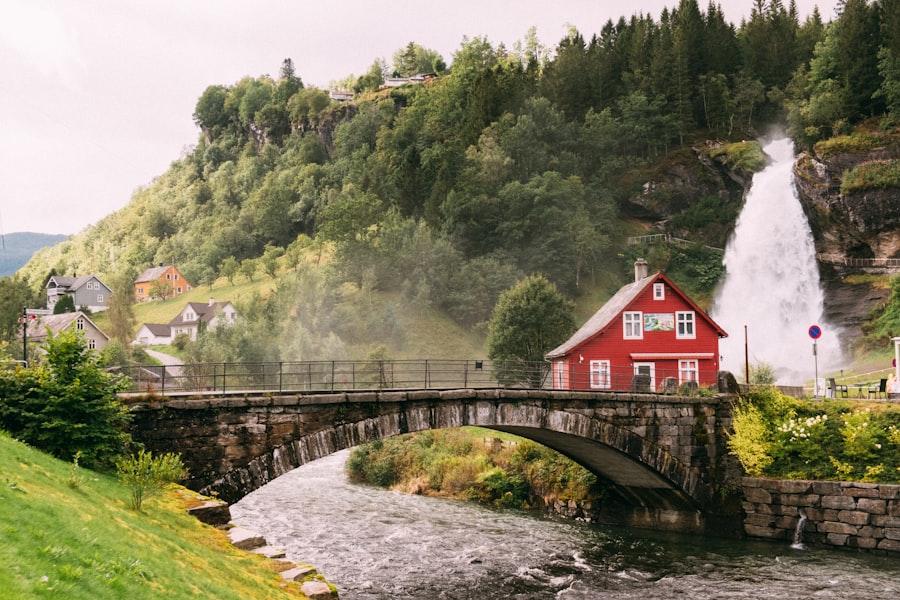Commuting in Norway presents a unique blend of challenges and opportunities, shaped by the country’s stunning landscapes and commitment to sustainability. With its vast fjords, towering mountains, and picturesque towns, Norway offers a variety of commuting options that cater to different lifestyles and preferences. The choice between driving and cycling is particularly significant, as both modes of transport have their own merits and drawbacks.
Understanding the nuances of commuting in this Nordic nation is essential for anyone looking to navigate its roads and trails effectively. Norway’s commitment to environmental sustainability has led to a growing emphasis on alternative modes of transport, particularly cycling. As cities like Oslo strive to reduce carbon emissions and promote healthier lifestyles, the infrastructure for cyclists has improved dramatically in recent years.
However, driving remains a popular choice for many, especially in rural areas where public transport options may be limited. This article will explore the pros and cons of both driving and cycling in Norway, providing insights into the costs, environmental impacts, safety considerations, and cultural factors that influence commuting decisions. Book your 1-hour strategy session with Norway Relocation Group.
Summary
- Commuting in Norway can be challenging due to long distances and varying weather conditions
- Pros of driving in Norway include convenience and flexibility, but cons include high costs and environmental impact
- Pros of cycling in Norway include health benefits and lower costs, but cons include weather challenges and safety concerns
- Cycling is generally cheaper than driving in Norway, considering factors such as fuel, parking, and maintenance costs
- Cycling has a lower environmental impact than driving, contributing to a more sustainable commute option
Pros and Cons of Driving in Norway
Driving in Norway offers a level of convenience that is hard to match. For those living in remote areas or regions with limited public transport, having a car can be essential for daily commuting. The freedom to travel at one’s own pace and the ability to carry larger loads make driving an attractive option for many Norwegians.
Furthermore, Norway’s well-maintained road network allows for smooth travel across the country, with scenic routes that can turn a mundane commute into a breathtaking journey. However, driving in Norway is not without its challenges. The cost of fuel, insurance, and maintenance can add up quickly, making it an expensive option for daily commuting.
Additionally, urban areas often face traffic congestion, particularly during peak hours. Parking can also be a hassle in cities like Oslo, where finding a space can be time-consuming and costly. Moreover, the environmental impact of driving cannot be overlooked; despite Norway’s efforts to promote electric vehicles, traditional petrol and diesel cars still contribute to air pollution and greenhouse gas emissions.
Pros and Cons of Cycling in Norway

Cycling has gained popularity in Norway as an eco-friendly alternative to driving. One of the most significant advantages of cycling is its positive impact on health; regular cycling can improve cardiovascular fitness and overall well-being. Additionally, cycling is often more cost-effective than driving, as it eliminates expenses related to fuel, parking, and maintenance.
For those who enjoy the outdoors, cycling allows for a more immersive experience of Norway’s stunning landscapes, making the daily commute feel less like a chore. On the flip side, cycling does come with its own set of challenges. Weather conditions can be unpredictable in Norway, with rain and snow making cycling less appealing during certain months.
Furthermore, while urban areas are increasingly accommodating cyclists, rural regions may lack adequate cycling infrastructure, making it difficult to navigate safely. Additionally, cyclists are more vulnerable on the road compared to drivers; accidents can lead to serious injuries, which raises concerns about safety.
When it comes to cost comparison between driving and cycling in Norway, the differences are stark. The expenses associated with owning and operating a car can be substantial. Fuel prices in Norway are among the highest in Europe, and when combined with insurance premiums, road taxes, and maintenance costs, the financial burden can be significant for daily commuters.
Moreover, parking fees in urban centres can further inflate the overall cost of driving. In contrast, cycling presents a much more economical option. The initial investment in a good-quality bicycle may seem steep, but it pales in comparison to the ongoing costs of car ownership.
Once purchased, bicycles require minimal maintenance and no fuel costs. Additionally, many cities offer free or low-cost bike parking facilities, further enhancing the financial appeal of cycling as a commuting option. For those looking to save money while staying active, cycling is undoubtedly the more budget-friendly choice.
The environmental impact of commuting choices is a pressing concern in today’s world, and Norway is no exception. Driving contributes significantly to carbon emissions and air pollution, even with the increasing adoption of electric vehicles. While electric cars are certainly a step in the right direction, they still require energy for charging and contribute to wear on road infrastructure.
The production of vehicles also has an environmental footprint that cannot be ignored. Cycling stands out as a far more sustainable mode of transport. It produces zero emissions during operation and requires far fewer resources for manufacturing compared to cars.
By choosing to cycle instead of drive, individuals can significantly reduce their carbon footprint while promoting cleaner air quality in urban areas. As cities like Oslo continue to invest in cycling infrastructure and encourage bike use through various initiatives, the environmental benefits of cycling become increasingly apparent.
Safety is a paramount concern for both drivers and cyclists in Norway. For drivers, adhering to traffic regulations and being vigilant about road conditions is crucial for preventing accidents. Norway’s roads can be challenging due to their winding nature and varying weather conditions; thus, drivers must remain alert at all times.
Additionally, the presence of wildlife on rural roads poses an added risk that drivers must consider. Cyclists face their own set of safety challenges on Norwegian roads. While many cities have made strides in creating dedicated bike lanes and improving cyclist visibility at intersections, accidents still occur.
Cyclists are often at greater risk during adverse weather conditions or when sharing roads with larger vehicles. Wearing helmets and high-visibility clothing can help mitigate some risks; however, it is essential for both cyclists and drivers to remain aware of each other on the road to ensure safety for all.
Infrastructure for Drivers in Norway
Norway boasts an extensive network of roads that facilitate driving across its diverse landscapes. The country’s commitment to maintaining high-quality infrastructure means that drivers can expect well-paved roads even in remote areas. Major cities are equipped with modern amenities such as parking garages and service stations that cater to motorists’ needs.
However, as urban areas grow increasingly congested, there is a push towards improving public transport options and reducing reliance on cars. This shift has led to discussions about investing more heavily in sustainable transport solutions rather than expanding road networks further. While driving remains a viable option for many Norwegians today, the future may see a gradual transition towards more environmentally friendly alternatives.
Infrastructure for Cyclists in Norway
In recent years, Norway has made significant strides in developing infrastructure for cyclists. Cities like Oslo have implemented dedicated bike lanes that separate cyclists from vehicular traffic, enhancing safety and encouraging more people to take up cycling as a mode of transport. Bike-sharing schemes have also gained popularity, providing residents with easy access to bicycles without the need for ownership.
Despite these advancements, challenges remain—particularly in rural areas where cycling infrastructure may be lacking or non-existent. While urban centres are becoming increasingly bike-friendly, there is still work to be done to ensure that all regions of Norway provide safe and accessible routes for cyclists. Continued investment in cycling infrastructure will be crucial for promoting this sustainable mode of transport across the entire country.
Weather Considerations for Drivers and Cyclists in Norway

Norway’s weather can be unpredictable and varies significantly across regions and seasons. For drivers, winter conditions pose particular challenges; snow-covered roads can lead to hazardous driving situations that require careful navigation and appropriate vehicle preparation such as winter tyres or snow chains. Rainy weather can also affect visibility and road conditions throughout the year.
Cyclists must also contend with weather-related challenges when commuting in Norway. Rain can make cycling uncomfortable or even dangerous due to slippery surfaces; similarly, snow and ice can render bike paths impassable during winter months. However, many dedicated cyclists embrace these conditions by investing in appropriate gear such as waterproof clothing or studded tyres for winter riding.
Ultimately, both drivers and cyclists must remain adaptable to changing weather conditions while prioritising safety.
Cultural Considerations for Drivers and Cyclists in Norway
Cultural attitudes towards commuting vary significantly between drivers and cyclists in Norway. In urban areas where cycling is promoted as an environmentally friendly alternative to driving, there is often a strong sense of community among cyclists who share similar values regarding sustainability and health. This cultural shift has led to increased acceptance of cycling as a legitimate mode of transport rather than merely a recreational activity.
Conversely, driving remains deeply ingrained in Norwegian culture—particularly in rural areas where cars are often seen as essential for daily life due to limited public transport options. While there is growing awareness about the environmental impact of car travel, many Norwegians still view driving as a symbol of freedom and independence. Balancing these cultural perspectives will be crucial as Norway continues its journey towards more sustainable commuting practices.
Making the Decision: Driving or Cycling for Your Daily Commute in Norway
Ultimately, the decision between driving or cycling for daily commuting in Norway depends on various factors including personal preferences, lifestyle choices, financial considerations, safety concerns, and environmental values. For those living in urban centres with access to robust cycling infrastructure and amenities such as bike-sharing schemes or dedicated lanes, cycling may emerge as the most practical option—offering both health benefits and cost savings. Conversely, individuals residing in rural areas or those who require flexibility due to work commitments may find driving more suitable despite its associated costs and environmental impact.
As cities like Oslo continue investing heavily into promoting cycling through improved infrastructure at institutions like NLS Norwegian Language School—where language courses encourage integration into local culture—there is hope that more people will embrace this sustainable mode of transport over time. In conclusion, whether one chooses to drive or cycle while commuting in Norway ultimately reflects individual circumstances alongside broader societal trends towards sustainability—an important consideration as we navigate our way through an ever-evolving landscape shaped by both tradition and innovation alike.
Speak Norwegian with confidence. Enroll in a class at the NLS Norwegian Language School now.

